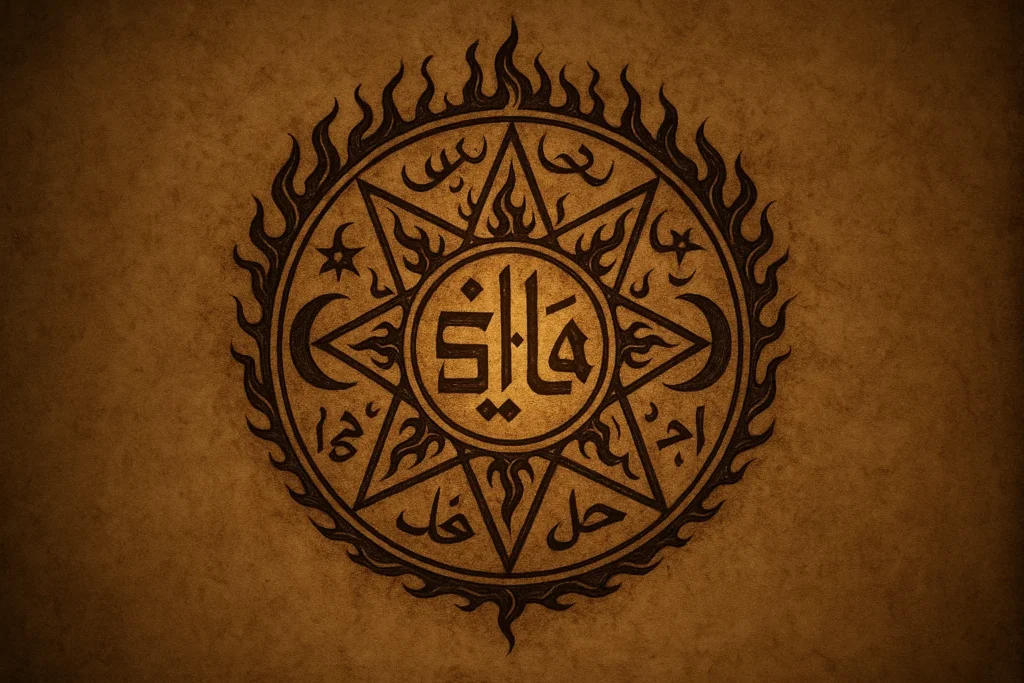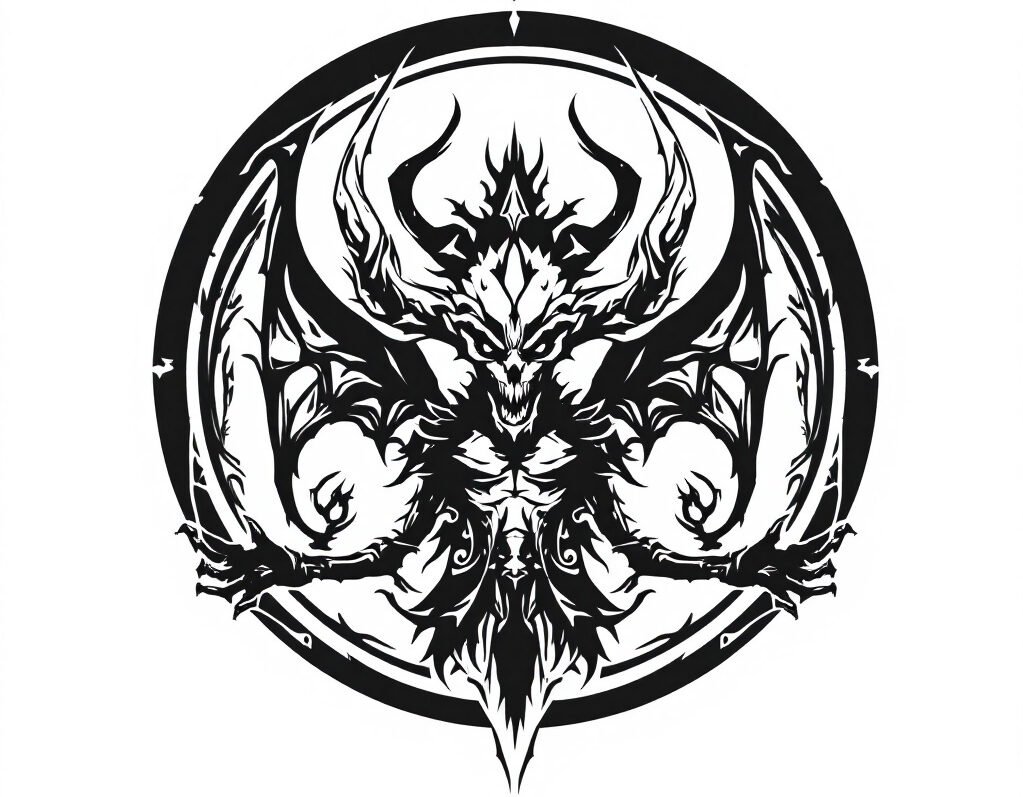Si’la are cunning, beautiful jinn from Arabian folklore, often known for their seductive and malevolent nature. Made from smokeless fire, they excel at deception, appearing as beautiful women to lure humans into danger or doom, especially in desolate desert areas.
Their hybrid forms, blending human beauty with animal traits such as hooves or glowing eyes, reveal their true, treacherous nature. While some tales speak of Si’la marrying humans or producing offspring, their intent is usually harmful, leading travelers astray or causing mental distress.
Rooted in pre-Islamic tales and later woven into Islamic lore, Si’la embody the perils of hidden evil, using charm and trickery to exploit human weaknesses.
Summary
Key Takeaways
| Attribute | Details |
|---|---|
| Names | Si’la, Sila, Si’lat, Sa’aali. |
| Type | Shapeshifting jinn, often seen as female counterparts to ghouls. |
| Title | None specified. |
| Gender | Typically female or ambiguous. |
| Servitors | None specified. |
| Superior Jinn | Iblis for malevolent ones, or none specified. |
| Powers | Shapeshifting into human or animal forms, seducing humans, leading travelers astray, causing harm through deception. |
| Appearance | Often appears as a beautiful woman with hybrid animal features, like animal feet or eyes, to hide true nature. |
| Etymology | From Arabic root meaning “hag” or “treacherous spirits of invariable form”; su’luwwa suggests slim, witty, powerful, and unloyal seductresses. |
| Associated Figures | Ghouls as male counterparts, Iblis as leader of evil jinn, humans like ‘Amr ibn Yarbu’ in folklore. |
| Weaknesses | Repelled by iron, wolves, Quranic verses like Ayat al-Kursi, and recitation of God’s names. |
| Opposing Holy Figure | Prophet Muhammad, Archangel Jibril, Prophet Sulayman who controlled jinn. |
| Social Structure or Tribe | Lives in desolate areas, part of malicious jinn groups, sometimes in tribes of shapeshifters. |
| Followers/Tribe Size | None specified, often solitary or in small groups. |
| Element | Fire. |
| Planet/Zodiac | None specified. |
| Color(s) | None specified. |
| Number(s) | None specified. |
| Crystal(s)/Mineral(s) | None specified. |
| Primary Sources | Arabian folklore, pre-Islamic poetry, works on jinn like those by Al-Jahiz, tales in One Thousand and One Nights. |
“Si’la” Meaning
The name “Si’la” originates from ancient Arabic words that refer to elusive and mysterious spirits. It links to roots meaning “hag” or “treacherous spirits of invariable form,” showing a being that stays true to its sneaky nature even when it changes shape.
In early texts, the term was tied to words like su’luwwa, which describe slim, smart women who are strong but not loyal, often seen as seducers. This description aligns with the lore, where these jinn deceive people with their appearance and cunning.
Over time, the meaning of the name Si’la changed slightly across different regions.
In pre-Islamic Arabia, it blended with ideas of ghouls, making Si’la their female side. Later stories maintained the focus on deception and shapeshifting, but also introduced connections to desert life and human cunning.
Over time, the definition expanded to include beings that could either marry humans or lead them to doom, always with a hint of danger. This shift demonstrates how folklore, combined with Islamic views, transformed old spirits into part of a larger world of jinn.
The etymology also hints at power in hidden ways. Words like this root show beings that adapt but keep their core evil, like how jinn hide from sight. In some old poems, Si’la names pop up as warnings about desert dangers.
How to Pronounce Si’la in English
In English, say Si’la like “see-lah,” with stress on the first part. The “Si” sounds like “see,” and “la” like “la” in “lava.” Some say it as “see-lat” for Si’lat, but keep it short and clear.
What Does Si’la Look Like?
Si’la often appears as a beautiful woman to lure in victims, but a closer look reveals odd aspects.
Sources suggest that they possess hybrid traits, such as animal feet—perhaps resembling donkey hooves or cat claws—that reveal their true form. Their eyes might glow strangely or shift in color, hinting at the beast within. The skin could be too smooth or pale, almost inhuman.
In tales, Si’la picks forms that fit the desert, blending with sand or rocks. When angry or caught off guard, they might transform into frightening hybrids (such as a woman with snake scales or bird wings). This mix makes them hard to spot at first, but the flaws show their jinn roots.
Old drawings in books depict them as slim figures with wild hair and eyes full of mischief. These looks tie to their powers, letting them hide flaws while seducing. However, the animal parts remind us of their wild side, living in remote places.
Origins
Si’la first appears in pre-Islamic Arabian tales, part of a world full of spirits in the desert. Before Islam, Arabs saw the wild lands as home to hidden beings that could help or harm. These early stories mixed these jinn with ghouls, initially treating them as synonyms.
Over time, Si’la evolved into the female version, known for its tricks and shapes. Tribes told of them in poems, warning nomads about desert lures. Poets like al-A’sha spoke of jinn as friends or foes, illustrating how these beings were a part of daily fears.
As Islam spread, these dangerous spirits were incorporated into broader jinn lore. The Quran discusses jinn in general, describing them as being made from fire, possessing free will, and having characteristics similar to humans. The new “description” essentially reframed old spirits as part of God’s creation, rather than as gods themselves.
However, folklore retained Si’la’s sneaky traits, adding Islamic twists, such as repulsion by prayers.
In poetry, they inspired fear or awe, like invisible watchers. Islam changed this by stressing God’s power over all, making Si’la less divine and more like flawed beings. Yet, stories lived on in books (like One Thousand and One Nights), blending old myths with new rules.
Was Si’la Ever Mentioned in the Quran or Hadith?
Si’la is not mentioned in the Quran or Hadith. These texts refer to jinn as a group, as seen in Surah al-Jinn, but do not specify individual types of jinn. This jinn originates from folklore and pre-Islamic tales, rather than core Islamic sources.
Si’la in Grimoires and Other Texts
Si’la appears in occult works and folklore beyond the main Islamic texts. In books on magic (such as those drawing from Arabian traditions), the spirit is typically linked to shapeshifting and seduction.
Authors describe them in tales of jinn tribes, often as part of malicious groups living in wild places. For example, in works like the Book of Wonders, jinn types get listed with powers, and Si’la fits the tricky female ones.
However, no exact quotes from grimoires name these spirits directly, but similar beings appear in sections on invoking spirits for deception or love.
You may also enjoy:
Iblis, the Jinn King of Darkness and Deception
September 29, 2025
Who Is Adrammelech in Demonology and the Bible?
October 1, 2025
Banasura: The Thousand-Armed Demon King
October 10, 2025
Palden Lhamo: The Black Goddess of Blood and Protection
October 20, 2025
Who Was Abezethibou, the Fallen Angel Who Opposed Moses?
October 1, 2025
Bali: The Benevolent Asura King of Hindu Mythology
October 10, 2025
Powers and Abilities
Compared to other jinn, Si’la holds a moderate power level, excelling in deception rather than raw strength. Unlike mighty Marids, who wield vast physical and magical might, or Ifrits, known for fiery destruction, Si’la rely on cunning and subtlety, similar to Ghouls but with a focus on seduction over brute force.
Their abilities center on manipulation, making them particularly dangerous in personal encounters rather than large-scale conflicts, which sets them apart from high-ranking jinn like Iblis.
Si’la’s powers and abilities include:
- Shapeshifting into human or animal forms to trick people: These spirits can morph into beautiful women (or animals like snakes) to deceive travelers, using flawless disguises to hide their hybrid traits until it’s too late.
- Seducing men, leading to marriage or harm: They charm men with irresistible allure, sometimes forming temporary unions that end in betrayal, abandonment, or death in desolate places.
- Leading travelers astray in deserts, causing death: They guide wanderers off paths with false promises or visions, leaving them lost in harsh deserts to perish from exposure.
- Causing possession or mental distress: They invade minds, sparking obsession, fear, or madness, often through dreams or whispers that prey on emotional weaknesses.
- Producing hybrid children with humans: In rare tales, these jinn can bear offspring with human partners, creating half-jinn beings with mixed traits, often tied to cursed lineages.
- Hiding their true nature with hybrid looks: Their forms blend human beauty with animal features, such as hooves or glowing eyes, allowing them to pass as human until victims notice the eerie flaws.
- Living unseen in desolate areas: Si’la dwell in remote deserts or ruins, staying invisible to avoid detection, emerging only to hunt or trick unsuspecting humans.
- Manipulating perceptions: They cast illusions to alter what people see or hear, creating false oases or voices to lure victims into traps or dangerous decisions.
Influence on Humans and Possession
Si’la impacts humans through tricks and close ties. In lore, they lure men with beauty, leading to seduction or marriage. This can end in harm, like being led to die in the desert. Their influence is evident in sudden urges or poor choices, such as straying from the path.
Possession occurs when one is weak, such as during sadness or when alone in wild places. Signs include strange dreams of beautiful women, feeling watched, or hybrid visions.
Manifestations vary; some feel pulled to empty lands, others get sick from “evil eye” like effects. In stories, people possessed by supernatural forces often act strangely, speaking in unknown languages or exhibiting animal-like traits.
According to folklore, Si’la targets lonely travelers, using charm to manipulate their minds. This leads to loss of will, where victims follow lures to doom. In some cases, possession causes fights in families, as the jinn stirs jealousy or lies.
Overall, Si’la’s hold is tied to human flaws like lust or fear, making it difficult to break free without help. Tales warn of these risks, showing how jinn exploit weakness.
Protection and Exorcism Methods
Historical remedies against Si’la include carrying iron objects (as jinn are believed to fear them). Wolves scare them, too, so staying near animals may help. Reciting Quranic verses, such as Ayat al-Kursi, was said to ward them off. In old practices, people uttered “destur” before actions to warn jinn.
For exorcism, methods used God’s names in prayers or charms. Scholars described rituals involving Quran reading over the possessed, sometimes accompanied by herbs or water blessed with verses. These were seen as ways to bind or banish, drawing from Prophet Sulayman’s control over jinn.

Si’la Myths, Legends, and Stories
The Marriage of ‘Amr ibn Yarbu’ and the Si’lat
In the arid expanses of ancient Arab lands, there lived a man named ‘Amr ibn Yarbu’, known for his adventurous spirit and deep wisdom. During one of his solitary journeys across the sun-scorched desert, he encountered an enchanting creature known as a si’lat.
She appeared before him in the form of a stunningly beautiful woman, her presence captivating him with an otherworldly allure. Their connection was immediate and profound, and it didn’t take long for them to fall deeply in love.
Embracing their extraordinary bond, ‘Amr and the si’lat wed, defying the boundaries between their worlds. From this union, they had several children, who came to be known as the Banu Si’lat. This lineage became the subject of whispered tales and legends, with many believing that these unique offspring were descendants of a mystical union between humans and jinn.
As the years passed, the si’lat lived contentedly with her family, but one fateful day, a brilliant flash of lightning tore across the twilight sky. Enchanted by its striking beauty, she felt a deep resonance within her soul—a call from her kin urging her to return to her jinn clan.
Torn between her love for ‘Amr and her innate connection to her otherworldly origins, she faced an agonizing choice. In a heart-wrenching decision, she bid farewell to her beloved husband and children, yearning to reunite with her people and honor the call of her true nature.
Si’la vs Other Jinn
| Jinn Name | Associated Traits/Influence | Rank/Origin | Key Traits/Powers |
|---|---|---|---|
| Ifrit | Mischief and revenge | High rank in fire jinn, Arabian folklore | Fiery strength, shape-changing, causing destruction |
| Marid | Pride and rebellion | Powerful sea-dwellers, Quran mentions | Grants wishes, lifts heavy weights, eavesdrops on heavens |
| Ghul | Grave-haunting and eating dead | Low malicious, pre-Islamic tales | Shapeshifting, luring to death, hybrid forms |
| Shaytan | Temptation and evil | Followers of Iblis, Quran and Hadith | Induces sin, whispers lies, possession |
| Jann | Hiding and adaptation | Ancestor jinn, early folklore | Snake forms, inspiration for poets, free will |
| Afarit | Harm and power | Strong demons, Moroccan beliefs | Possession, fulfilling dark wishes, greater existence |
| Qarin | Personal temptation | Companion jinn, Islamic tradition | Influences thoughts, tied to each human |
| Hinn | Weak malice | Low jinn, ancient texts | Dog-like forms, minor tricks |
| Nasnas | Deformity and fear | Half-human jinn, folklore | One-legged, causes fright, limited powers |
| Palis | Foot-licking harm | Malicious type, Arabian lore | Sucks blood from feet, causes weakness |
| Vetala | Possession of corpses | Spirit-like, Indian-Arab blend | Animates dead, riddles, knowledge of past |
| Dēw | Giant evil | Persian-Arab, folklore | Massive size, battles heroes, causes chaos |
| Pari | Beauty and trickery | Fairy-like jinn, Persian influence | Flight, invisibility, lures with allure |
| Abḳarī | Intelligence and wit | Smart jinn, old texts | Great knowledge, aids in magic |
Position Among Jinn
Si’la holds a spot among malicious jinn, not at the top, but known for tricks. In jinn groups, they align with shapeshifters like ghouls, acting as their female counterparts. They report to higher evil ones (such as Iblis), following his rebellious ways. However, Si’la often works alone or in small desert bands, rather than large armies.
Relationships vary; they pair with ghouls as counterparts, sharing luring tactics. With ifrits or marids, Si’la might ally for bigger harms, using charm where others use force. In lore, they avoid good jinn, clashing over human ties. Their role stresses deception, making them key in tales of stray travelers.
Overall, these evil jinn rank mid-level, strong in wits but not raw power. This lets them weave into human lives, causing subtle chaos.

Mystical Correspondences
| Attribute | Details |
|---|---|
| Planet | None specified |
| Zodiac Sign | None specified |
| Element | Fire |
| Direction | South |
| Color | Black |
| Number | None specified |
| Crystal/Mineral | None specified |
| Metal | Iron |
| Herb/Plant | None specified |
| Animal | Snake |
Si’la links to fire—like most jinn—showing quick changes and hidden heat. This element points to their tricky side, burning trust with lies. No clear planet or zodiac ties exist, but seduction hints at Venus-like pulls, maybe Scorpio for deep secrets.
These links help grasp Si’la’s dark core, using symbols in old rituals to call or ward them. Fire’s south direction ties to passion, fitting their lures. Black color shows void and deceit, while snakes reflect sly shifts.
Si’la’s Sigil
There isn’t a specific symbol for this jinn in ancient texts. Typically, symbols used to represent jinn include Arabic letters, squares, or stars, such as the famous Seal of Sulayman.
These symbols were often drawn on protective charms to summon or control spirits. Historically, such symbols were created by combining verses from the Quran with various shapes to protect people from mischievous jinn, including Si’la.
Summoning and Rituals
Historical summoning methods for jinn, like Si’la, originate from ancient magic books. They often used circles drawn with salt or chalk to keep the spirit in place. Incantations repeated God’s names or verses to command them. Tools like wands or rings, inspired by Sulayman’s ring, helped bind the jinn.
In grimoires, rituals required the right times (such as nights in deserts), accompanied by offerings or smoke. Commands focused on revealing truths or granting powers, but with risks of backlash.
You may also enjoy:
Rāga: The Seductive Demon of Passion and Desire in Buddhist Lore
October 16, 2025
Agubanba: The Ash-Born Demon of Japanese Folklore
October 23, 2025
Mahakala: The Dark Guardian Who Consumes Evil
October 16, 2025
Si’la: The Seductive Jinn Who Lures Travelers to Their Doom
October 9, 2025
Who Is Aka Manto, Japan’s Terrifying Red-Cloaked Yōkai?
October 24, 2025
Vaisravana: The Golden Guardian King Who Rules the North
October 16, 2025

